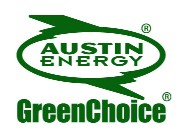Last Thursday Austin Energy General Manager Roger Duncan briefed Austin City Council on the utility’s Resource and Climate Protection Plan. This plan is the culmination of 18 months of input from the public, the creation of a generation resource task force of various stakeholders to review various energy plans and make recommendations, and support and input from both the Electric Utility Commission and the Resource Management Commission — but it still isn’t the end of the line for the plan. The generation plan will also be the subject of a city-wide town hall meeting February 22nd, and city council is expected to vote on some version of it in March.
The energy plan that Duncan (who will be retiring soon and we wish him the very best) presented sets Austin on a path to reduce our carbon emissions 20% below 2005 levels by 2020 and get a total of 35% of our energy from renewable resources. It will meet council’s renewable energy goals, move Austin Energy towards becoming the leading utility in the nation in terms of clean energy and global warming solutions, and re-affirm the city’s commitment to the Climate Protection Plan, which has the laudable goal to establish a cap and reduction plan for the utility’s carbon dioxide emissions. It is a flexible, living document that will allow council to evolve and adapt as conditions change. AND it will reduce the capacity factor of our Fayette Coal Plant to 60% and gets the ball rolling on figuring out the best way to shut it down(which you know makes me happy). Sounds like a pretty sweet deal, doesn’t it?
As we’ve come to expect over the years from our award winning utility, Austin Energy is taking an especially responsible and forward-thinking role with this new plan. I’ve formed this opinion for a few reasons:
- They’re adopting aggressive renewable energy and efficiency goals as part of a larger, smart business plan. Austin doesn’t need a new generation plan because we’re going to be strapped for energy by 2020; Austin Energy could rest on their laurels and do nothing for the next ten years and we’d be fine buying up excess energy on the open market as its power purchase agreements expire and gas plants age. But if they did that, by the time 2020 rolled around Austin would be way behind the technological curve and very likely be stuck with higher rates as a result. Austin Energy has picked up on the national trend that the traditional fuels we rely upon, such as coal, are quickly becoming financial liabilities even as solar and wind are becoming more and more cost effective. This plan will allow the utility to reposition itself for 2020 going forward so that in ten years we will have made the preparations necessary to take full advantage of the coming clean tech boom rather than be left scrambling and dependent on outdated energy sources.
- Austin Energy and the task force that helped formulate this plan were very careful to balance considerations of reliability, affordability, and clean (in terms of the environment and human health). The city has the responsibility to make sure that everyone who lives here can afford their utility bills. It doesn’t do any good to make the switch to a new clean economy if we do so on the backs of those that can least afford it. But that couldn’t be farther from the case with this plan; this isn’t green for some, this is green for all. Compared to other options, this plan will minimize the impact for those least able to pay their electricity bill, supports in-house economic development and the hiring of local contractors, and ensures that everyone will have a chance to play a role in moving our city and economy forward. There’s been a lot of focus and attention on the utility’s estimate that the plan will raise rates in 2020 by approximately 22% or $21 a month, but what’s missing from that discussion is that even if Austin Energy doesn’t do anything between now and 2020 rates will go up by 15% or about $14 a month. So do the math — for an extra $7 a month in ten years, we can build up a clean local economy that minimizes impacts on low-income consumers and creates avenues to new employment opportunities, improves public health, AND puts Austin in a prime position to start lowering rates by taking advantage of cheap renewable energy. OR we can save families $7 a month compared to today on their utility bills but lose out on new jobs and leave every citizen in the city of Austin at the mercy of high fossil fuel costs and coming federal regulations on greenhouse gas emissions. Austin Energy is not only looking at what is most affordable now, but what is most affordable in the long term. Coal may be cheap and reliable energy now, but depending on it in the long term will get us into trouble in terms of cheap and affordable in 2020.
- Austin Energy is not only reaching for the low fruit of emissions reductions and energy efficiency, they’re building high-tech ladders to get at the really juicy stuff at the top of the tree. Let me explain. There are a number of ways Austin Energy could go about reducing emissions. The easiest of these would be to buy renewable energy credits, or RECs. RECs and offsets are in essence a mechanism for utilities, businesses, and governmental bodies to pay someone else to clean up and still get the credit for it. They’re a good and have a positive influence on society at large because they do encourage clean energy investment and development, but not necessarily in a nearby community (in fact almost certainly not). It might be easier in the short run to pay someone else to be clean up, but then we miss out on all the delicious creamy gravy that comes along with renewable energy development. If you buy RECs you don’t get new jobs and businesses in your community. If you buy RECs your own people are still breathing the same amount of pollution. But Austin Energy is taking the initiative to really get at the heart of the problem by cutting the amount of pollution coming out of the smokestacks we own. For that, they should be applauded.
This is just my own personal take-away from listening to various people discuss the recommendation plan and hearing Roger Duncan’s presentation to council. You can learn a lot more about the process and final recommended plan by visiting AustinSmartEnergy.com or CleanEnergyforAustin.org. Join us after the jump for some fast facts on the various components of the plan, but for the real nitty gritty check out Duncan’s own powerpoint presentation.
 Roger Duncan announced his retirement today. Although it is sad to see a dedicated public servant move on, Public Citizen congratulates him on a fine career as general manager of Austin Energy, a municipal power company.
Roger Duncan announced his retirement today. Although it is sad to see a dedicated public servant move on, Public Citizen congratulates him on a fine career as general manager of Austin Energy, a municipal power company. It has been less than 24 hours since I received a copy of
It has been less than 24 hours since I received a copy of  After a rash of local and national press about the recent failure of Austin Energy’s GreenChoice program,
After a rash of local and national press about the recent failure of Austin Energy’s GreenChoice program,  There is too much fun going on in the next few days… I can’t handle it. I wish I could be multiple places at once… and influence climate change legislation by sheer will power.. and attach documents to e-mails telepathically. Ah well, if wishes were horses, I’d have gotten that pony when I was six.
There is too much fun going on in the next few days… I can’t handle it. I wish I could be multiple places at once… and influence climate change legislation by sheer will power.. and attach documents to e-mails telepathically. Ah well, if wishes were horses, I’d have gotten that pony when I was six. As expected, the Austin City Council made the decision to delay the vote on Austin Energy’s proposed solar plant until March 5th. Council Member Mike Martinez wanted to put it off longer, but since the bid for the plant will actually expire just seven days after this March meeting, the council agreed unanimously to have the final vote in three weeks time.
As expected, the Austin City Council made the decision to delay the vote on Austin Energy’s proposed solar plant until March 5th. Council Member Mike Martinez wanted to put it off longer, but since the bid for the plant will actually expire just seven days after this March meeting, the council agreed unanimously to have the final vote in three weeks time.



